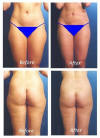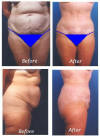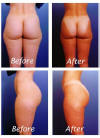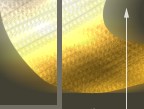



Procedures
Liposuction
See the Photo Gallery
Call to request information or schedule a consultation: Contact Us
Introduction: Liposuction,
known technically as lipoplasty or suction lipectomy, is a
procedure that can help sculpt the body by removing unwanted fat
from between the skin and muscle. Depending on the individual
patient, lipoplasty may result in dramatic changes in your
silhouette by contouring and defining specific body areas. The
most commonly treated areas in women are the abdomen, hips,
buttocks, thighs, knees, upper arms, chin, cheeks, and neck. In
men, the commonly areas treated include the love handles,
abdomen, breasts, neck, and chin.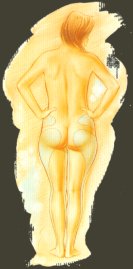

Significant improvements in liposuction technology have occurred during the last ten years. One, the tumescent technique, is routinely used and favored by Dr. Shienbaum, providing more precise results and a speedier recovery. Although liposuction is not a substitute for proper dieting and exercise, it can remove stubborn areas of fat that refuse to respond to traditional weight-loss methods. If you do not gain excessive weight following your procedure, liposuction can represent a permanent fat loss in the areas treated.
Candidates for liposuction: You must have realistic expectations about what liposuction can do for you. While the procedure can enhance your appearance and help boost self confidence, it won't necessarily alter your appearance to match an ideal or unrealistic body shape. You should seriously consider what you want to achieve, identify your expectations, and discuss these with Dr. Shienbaum.
While there is no weight limit for liposuction, the best candidates are people with firm, elastic skin who experience pockets of excess fat in certain areas. Age also is not a major factor; however, you should understand that older patients may have reduced skin elasticity and may not achieve the same results as a younger patient with tighter skin. Physical health is important.
Surgical procedures: As mentioned above, Dr. Shienbaum is highly trained in and routinely employs the tumescent technique for liposuction. This technique is the most common and is considered the safest form of liposuction for removing large amounts of fat because there is minimal blood loss. In this technique, Dr. Shienbaum will inject a salt-water solution beneath the skin in the area to be suctioned. The solution may contain small amount of a local anesthetic, usually lidocaine, and the hormone epinephrine. The anesthetic numbs the area and reduces postoperative discomfort, while the epinephrine reduces bruising and allowing for removal of more fat during a single procedure.
There is a limit on the amount of fat that can be removed during a procedure. This is determined for each individual at your consultation. Should a larger amount, or more areas, of fat removal be desired than can be completed during one treatment, a second procedure will be required at a later date.
Removal of the fat cells involves the use of a micro or small tube, called a cannula, which is connected to a powerful suction machine. The cannula is inserted under the skin through very small incisions. Dr. Shienbaum strives to keep the incision sites as inconspicuous as possible for your procedure. Fat removal is accomplished as the suction cannula creates tiny tunnels through the fatty layers; the tunnels then collapse following removal of the fat.
As with any surgical procedure, liposuction has certain common side effects, such as bruising, swelling, and temporary numbness. Although irregularities of the skin are possible, this is minimized by use of the micro cannula.
Planning your surgery: Dr. Shienbaum and his staff at Brandon Plastic Surgery welcome you to a complementary initial consultation during which your desires and expectations will be discussed. In your initial consultation, you will visit with the professional staff that will take your medical history. The Doctor will evaluate your health, conduct an examination, and provide his recommendations on the procedure most appropriate for you. It is important for you to be frank with the Doctor and for you to know that the Doctor will be frank with you, describing his technique, alternatives, limitations, and risks. Dr. Shienbaum also will explain the anesthesia that will be used during your procedure. The staff will provide you with the opportunity to view photos of previous patients so that you may better comprehend likely results, information about the facility where your surgery will be performed, and appropriate expenses.
Upon your decision to proceed with lipoplasty, the staff will work with you to arrange a surgery date, answer any other questions, review consent forms, and take photographs. Dr. Shienbaum uses an advanced digital imagery camera and storage on an automated imagery filer to immediately record photographs.
The staff will also provide you with instructions in preparation for your surgery. These will include guidance on eating, drinking, smoking, and the taking or avoidance of certain medications and vitamins. You will need to arrange for transportation from the facility and should have some assistance to help or to provide care following your surgery.
Where your surgery will occur? Dr. Shienbaum will perform your liposuction in a local, fully accredited ambulatory surgical facility. While this procedure is typically conducted in an outpatient facility, Doctor Shienbaum has privileges at area hospitals where he is recognized as a board-certified Plastic Surgeon and Otolarnygologist.
Your surgery and anesthesia: Upon your arrival for your surgery, all pre-operative laboratory work will be accomplished. Various types of anesthesia can be used for liposuction procedures, which will have been discussed with you and decided during your consultation. The type of anesthesia you will receive will provide the safest and most effective level of comfort for your surgery. If only a small amount of fat and a limited number of body sites are involved, liposuction may be performed under local anesthesia, which numbs only the affected areas. For more extensive procedures, sedatives or general anesthesia will be the proper choice.
The extent of your specific procedure requirements will dictate the duration of the surgery. The time required to perform liposuction may vary considerably, depending on the size of the area, the amount of fat being removed, and the type of anesthesia. You will be fitted with an elastic compression garment that will encompass the portions of your body that were treated. This ensures proper healing and minimalization of skin irregularities and will be worn for several weeks following the procedure. After completion of your surgery, you will be moved to a recovery room or area.
While in recovery, your body will release itself from the anesthetic sleep. A nurse will be constantly monitoring your vital signs, checking for bleeding and drainage from the incisions, and will ensure that you are warm and comfortable. Recovery time is dependent on the anesthesia used and your individual physiology. A normal recovery stay of one to two hours should be expected. A member of Dr. Shienbaums nursing staff will contact you in the evening to check on your status. It is important that you provide the staff with a contact phone number.
When you make preparations for your surgery, arrange for someone to drive you home after the procedure and, if needed, to help you at home for a day or two.
After your surgery: You will likely feel light-headed and sore the first 24 hours after your procedure and you should expect some swelling and discomfort. You will be seen in our office on the day following your surgery. During this visit you will be evaluated, your dressings changed, and you will be provided with further post-operative instructions, as needed. You will likely have experienced some fluid drainage from the small incisions.
You should expect to be up and around in 24 to 48 hours following the surgery. Most discomfort that you experience will be controlled by medication, but should subside within 3 to 4 days. Healing is a gradual process and is dependent on your individual physiology, diet, and exercise; you should start walking around as soon as possible to reduce swelling and to help prevent blood clots from forming in your legs. Some patients experience more soreness than others, but most are pleased with how quickly they are able to return to normal activities. You will begin to feel better after about a week or two and you should be back at work within a few days following your surgery. Any complications noted during your healing period should be immediately brought to the attention of Dr. Shienbaum.
Follow-on examinations will be scheduled based on your personal progress.
The new body contour should emerge in the first 2 weeks as swelling subsides, but it is possible some swelling may remain for several months. You should be able to resume most non-physical activities within 1 week. Most patients are completely healed and back to full activities within 4 to 8 weeks.
Frequently asked questions: This section provides information in response to questions or subjects routinely posed by our patients:
1. Will the fat grow back? Liposuction involves the permanent removal of fat cells. While significant amounts of fat can be removed during a single procedure, not all fat cells are removed. Therefore, fat cells remaining in problem areas can eventually grow with excess weight gain. Ensuring a healthy diet and maintaining an appropriate level of exercise will prevent growth of those cells that remain.
2. How much fat can you remove? The amount, or volume of fat that can be suctioned is dependent on each individuals physiology, presentation, and health. It is important that you be properly evaluated during your complementary consultation and that Dr. Shienbaum is fully aware of your medical history in order to make this determination. While liposuction techniques have improved to permit removal of a significant amount of fat during a single procedure, the surgery is not a treatment for chronic excessive obesity.
3. What risk categories may prevent me from having liposuction? People with certain medical conditions, including diabetes, heart disease, lung disease, and poor blood circulation are at increased risk for complications from liposuction.
4. Resumption of activities. Dr Shienbaum recommends a return to as much activity as is comfortable within 2 to 4 weeks after your surgery.
5. How will the area treated appear? The incision scars from liposuction are small, usually about one half-inch of less, and strategically placed to be hidden from view. Imperfections in the final appearance are not uncommon after lipoplasty and usually are dependent on the elasticity of the patients skin.
813-681-5709
Home
~~ Contact
Us ~~
Practice Info
~~ Dr.
Shienbaum ~~
Photo Gallery






